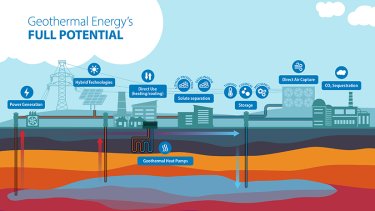
HW1 : Power Plant
GEOTHERMAL POWER TECHNOLOGY Geothermal energy comes from heat within the Earth and can be used for heating or making electricity. It’s different from solar and wind because it’s available all year round and can be found almost anywhere. But to make electricity, we need areas with lots of heat, usually near volcanoes. Geothermal energy is […]
GEOTHERMAL POWER TECHNOLOGY
Geothermal energy comes from heat within the Earth and can be used for heating or making electricity. It’s different from solar and wind because it’s available all year round and can be found almost anywhere. But to make electricity, we need areas with lots of heat, usually near volcanoes.
Geothermal energy is heat from deep within the Earth. It’s carried to the surface by water or steam. This heat can be used for heating, cooling, or making electricity. Geothermal power plants are really reliable and can provide electricity all the time. They also emit fewer greenhouse gases than fossil fuel plants. Geothermal energy is available almost everywhere, but the best spots for generating electricity from it are near volcanoes where the Earth’s heat is high for example, situated along plate boundaries (subduction zones, such as the majority of the Pacific “Ring of Fire”), mid-oceanic ridges (such as Iceland and the Azores) and rift valleys (such as the East African Rift) or near hot spots (such as in Hawaii).
Power generation from geothermal fields depends on the heat they contain. There are four main methods for generating power from geothermal energy. One method, called direct dry steam plants (Fig 1), uses steam turbines to convert high-temperature steam directly into electricity. These plants range in size from 8 MW to 140 MW. Flash plants and binary plants are two common types of geothermal electricity plants. Flash plants work by separating hot water into steam and water. The steam spins turbines to generate electricity, while the water is reused or sent for further heating. These plants need water temperatures above 180°C and can vary in size. Binary plants (Fig 2) are used in areas with lower temperature geothermal resources. They use heat exchangers to transfer heat from the geothermal fluid to another fluid with a lower boiling point, like ammonia or hydrocarbons. This fluid then powers a turbine to generate electricity. Binary plants are smaller in size compared to flash plants.
Some geothermal plants use combined-cycle or hybrid systems to boost electricity production efficiently. Combined-cycle plants add a traditional Rankine cycle to a binary cycle, while hybrid plants combine geothermal energy with other sources like concentrated solar power or biomass. For instance, the Stillwater project in the US combines concentrated solar power with a geothermal binary system.
Fig 1 : Direct steam plant (IRENA, 2017b)
Fig 2 : Binary plant (IRENA, 2017b)
References :
– IRENA (International Renewable Energy Agency) (2017a). “Renewable Cost Database”, IRENA, http:// costing.irena.org/irena-costing.aspx.
– IRENA (International Renewable Energy Agency) (2017b). “Project Navigator: Technical Concept Guidelines for Geothermal Projects 2017”, IRENA, https://navigator.irena.org/index.html.
This article is a part of the class “751447 SEM IN CUR ECON PROB” supervised by Asst. Prof. Napon Hongsakulvasu. Faculty of Economics, Chiang Mai University.
This article was written by Ratthathammanun Suriya 631615043
